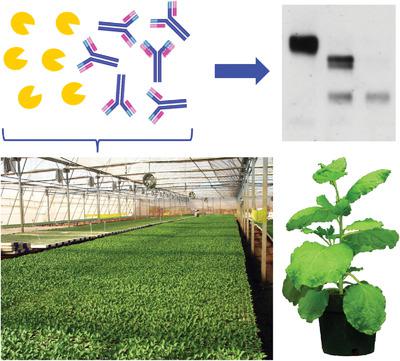当前位置:
X-MOL 学术
›
Biotechnol. J.
›
论文详情
Our official English website, www.x-mol.net, welcomes your feedback! (Note: you will need to create a separate account there.)
Steric Accessibility of the Cleavage Sites Dictates the Proteolytic Vulnerability of the Anti-HIV-1 Antibodies 2F5, 2G12, and PG9 in Plants.
Biotechnology Journal ( IF 4.7 ) Pub Date : 2019-10-28 , DOI: 10.1002/biot.201900308 Alejandro A Puchol Tarazona 1 , Elisabeth Lobner 2 , Yvonne Taubenschmid 1 , Melanie Paireder 1 , Juan A Torres Acosta 1 , Kathrin Göritzer 1 , Herta Steinkellner 1 , Lukas Mach 1
Biotechnology Journal ( IF 4.7 ) Pub Date : 2019-10-28 , DOI: 10.1002/biot.201900308 Alejandro A Puchol Tarazona 1 , Elisabeth Lobner 2 , Yvonne Taubenschmid 1 , Melanie Paireder 1 , Juan A Torres Acosta 1 , Kathrin Göritzer 1 , Herta Steinkellner 1 , Lukas Mach 1
Affiliation

|
Broadly neutralizing antibodies (bNAbs) to human immunodeficiency virus type 1 (HIV-1) hold great promise for immunoprophylaxis and the suppression of viremia in HIV-positive individuals. Several studies have demonstrated that plants as Nicotiana benthamiana are suitable hosts for the generation of protective anti-HIV-1 antibodies. However, the production of the anti-HIV-1 bNAbs 2F5 and PG9 in N. benthamiana is associated with their processing by apoplastic proteases in the complementarity-determining-region (CDR) H3 loops of the heavy chains. Here, it is shown that apoplastic proteases can also cleave the CDR H3 loop of the bNAb 2G12 when the unusual domain exchange between its heavy chains is prevented by the replacement of Ile19 with Arg. It is demonstrated that CDR H3 proteolysis leads to a strong reduction of the antigen-binding potencies of 2F5, PG9, and 2G12-I19R. Inhibitor profiling experiments indicate that different subtilisin-like serine proteases account for bNAb fragmentation in the apoplast. Differential scanning calorimetry experiments corroborate that the antigen-binding domains of wild-type 2G12 and 4E10 are more compact than those of proteolysis-sensitive antibodies, thus shielding their CDR H3 regions from proteolytic attack. This suggests that the extent of proteolytic inactivation of bNAbs in plants is primarily dictated by the steric accessibility of their CDR H3 loops.
中文翻译:

切割位点的空间可及性决定了植物中抗 HIV-1 抗体 2F5、2G12 和 PG9 的蛋白水解脆弱性。
针对人类免疫缺陷病毒 1 型 (HIV-1) 的广泛中和抗体 (bNAb) 对免疫预防和抑制 HIV 阳性个体的病毒血症具有很大的前景。几项研究表明,本氏烟草等植物是产生保护性抗 HIV-1 抗体的合适宿主。然而,本氏烟草中抗 HIV-1 bNAbs 2F5 和 PG9 的产生与它们在重链的互补决定区 (CDR) H3 环中的质外体蛋白酶的加工有关。此处显示,当通过用 Arg 替换 Ile19 来防止其重链之间的异常结构域交换时,质外体蛋白酶也可以切割 bNAb 2G12 的 CDR H3 环。已证明 CDR H3 蛋白水解导致 2F5、PG9 和 2G12-I19R 的抗原结合能力的强烈降低。抑制剂谱实验表明,不同的枯草杆菌蛋白酶样丝氨酸蛋白酶解释了质外体中的 bNAb 片段化。差示扫描量热法实验证实,野生型 2G12 和 4E10 的抗原结合结构域比蛋白水解敏感抗体的抗原结合结构域更紧凑,从而保护其 CDR H3 区域免受蛋白水解攻击。这表明植物中 bNAb 的蛋白水解失活程度主要取决于其 CDR H3 环的空间可及性。差示扫描量热法实验证实,野生型 2G12 和 4E10 的抗原结合结构域比蛋白水解敏感抗体的抗原结合结构域更紧凑,从而保护其 CDR H3 区域免受蛋白水解攻击。这表明植物中 bNAb 的蛋白水解失活程度主要取决于其 CDR H3 环的空间可及性。差示扫描量热法实验证实,野生型 2G12 和 4E10 的抗原结合结构域比蛋白水解敏感抗体的抗原结合结构域更紧凑,从而保护其 CDR H3 区域免受蛋白水解攻击。这表明植物中 bNAb 的蛋白水解失活程度主要取决于其 CDR H3 环的空间可及性。
更新日期:2019-11-08
中文翻译:

切割位点的空间可及性决定了植物中抗 HIV-1 抗体 2F5、2G12 和 PG9 的蛋白水解脆弱性。
针对人类免疫缺陷病毒 1 型 (HIV-1) 的广泛中和抗体 (bNAb) 对免疫预防和抑制 HIV 阳性个体的病毒血症具有很大的前景。几项研究表明,本氏烟草等植物是产生保护性抗 HIV-1 抗体的合适宿主。然而,本氏烟草中抗 HIV-1 bNAbs 2F5 和 PG9 的产生与它们在重链的互补决定区 (CDR) H3 环中的质外体蛋白酶的加工有关。此处显示,当通过用 Arg 替换 Ile19 来防止其重链之间的异常结构域交换时,质外体蛋白酶也可以切割 bNAb 2G12 的 CDR H3 环。已证明 CDR H3 蛋白水解导致 2F5、PG9 和 2G12-I19R 的抗原结合能力的强烈降低。抑制剂谱实验表明,不同的枯草杆菌蛋白酶样丝氨酸蛋白酶解释了质外体中的 bNAb 片段化。差示扫描量热法实验证实,野生型 2G12 和 4E10 的抗原结合结构域比蛋白水解敏感抗体的抗原结合结构域更紧凑,从而保护其 CDR H3 区域免受蛋白水解攻击。这表明植物中 bNAb 的蛋白水解失活程度主要取决于其 CDR H3 环的空间可及性。差示扫描量热法实验证实,野生型 2G12 和 4E10 的抗原结合结构域比蛋白水解敏感抗体的抗原结合结构域更紧凑,从而保护其 CDR H3 区域免受蛋白水解攻击。这表明植物中 bNAb 的蛋白水解失活程度主要取决于其 CDR H3 环的空间可及性。差示扫描量热法实验证实,野生型 2G12 和 4E10 的抗原结合结构域比蛋白水解敏感抗体的抗原结合结构域更紧凑,从而保护其 CDR H3 区域免受蛋白水解攻击。这表明植物中 bNAb 的蛋白水解失活程度主要取决于其 CDR H3 环的空间可及性。



























 京公网安备 11010802027423号
京公网安备 11010802027423号